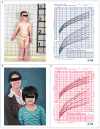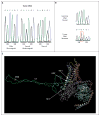Gigantism and acromegaly due to Xq26 microduplications and GPR101 mutation
- PMID: 25470569
- PMCID: PMC4291174
- DOI: 10.1056/NEJMoa1408028
Gigantism and acromegaly due to Xq26 microduplications and GPR101 mutation
Abstract
Background: Increased secretion of growth hormone leads to gigantism in children and acromegaly in adults; the genetic causes of gigantism and acromegaly are poorly understood.
Methods: We performed clinical and genetic studies of samples obtained from 43 patients with gigantism and then sequenced an implicated gene in samples from 248 patients with acromegaly.
Results: We observed microduplication on chromosome Xq26.3 in samples from 13 patients with gigantism; of these samples, 4 were obtained from members of two unrelated kindreds, and 9 were from patients with sporadic cases. All the patients had disease onset during early childhood. Of the patients with gigantism who did not carry an Xq26.3 microduplication, none presented before the age of 5 years. Genomic characterization of the Xq26.3 region suggests that the microduplications are generated during chromosome replication and that they contain four protein-coding genes. Only one of these genes, GPR101, which encodes a G-protein-coupled receptor, was overexpressed in patients' pituitary lesions. We identified a recurrent GPR101 mutation (p.E308D) in 11 of 248 patients with acromegaly, with the mutation found mostly in tumors. When the mutation was transfected into rat GH3 cells, it led to increased release of growth hormone and proliferation of growth hormone-producing cells.
Conclusions: We describe a pediatric disorder (which we have termed X-linked acrogigantism [X-LAG]) that is caused by an Xq26.3 genomic duplication and is characterized by early-onset gigantism resulting from an excess of growth hormone. Duplication of GPR101 probably causes X-LAG. We also found a recurrent mutation in GPR101 in some adults with acromegaly. (Funded by the Eunice Kennedy Shriver National Institute of Child Health and Human Development and others.).
Figures





Comment in
-
Genetics: X-linked acrogigantism--genetic characterization of a newly described paediatric growth disorder.Nat Rev Endocrinol. 2015 Feb;11(2):64. doi: 10.1038/nrendo.2014.230. Epub 2014 Dec 23. Nat Rev Endocrinol. 2015. PMID: 25534195 No abstract available.
-
Gigantism, acromegaly, and GPR101 mutations.N Engl J Med. 2015 Mar 26;372(13):1265. doi: 10.1056/NEJMc1500340. N Engl J Med. 2015. PMID: 25806919 No abstract available.
-
Gigantism, acromegaly, and GPR101 mutations.N Engl J Med. 2015 Mar 26;372(13):1264. doi: 10.1056/NEJMc1500340. N Engl J Med. 2015. PMID: 25806920 No abstract available.
-
Gigantism, acromegaly, and GPR101 mutations.N Engl J Med. 2015 Mar 26;372(13):1264-5. doi: 10.1056/NEJMc1500340. N Engl J Med. 2015. PMID: 25806921 No abstract available.
Similar articles
-
Germline or somatic GPR101 duplication leads to X-linked acrogigantism: a clinico-pathological and genetic study.Acta Neuropathol Commun. 2016 Jun 1;4(1):56. doi: 10.1186/s40478-016-0328-1. Acta Neuropathol Commun. 2016. PMID: 27245663 Free PMC article.
-
An orphan G-protein-coupled receptor causes human gigantism and/or acromegaly: Molecular biology and clinical correlations.Best Pract Res Clin Endocrinol Metab. 2018 Apr;32(2):125-140. doi: 10.1016/j.beem.2018.02.004. Epub 2018 Mar 17. Best Pract Res Clin Endocrinol Metab. 2018. PMID: 29678281 Review.
-
Gigantism: X-linked acrogigantism and GPR101 mutations.Growth Horm IGF Res. 2016 Oct-Dec;30-31:64-69. doi: 10.1016/j.ghir.2016.09.007. Epub 2016 Sep 29. Growth Horm IGF Res. 2016. PMID: 27743704 Review.
-
Mutations in GPR101 as a potential cause of X-linked acrogigantism and acromegaly.Prog Mol Biol Transl Sci. 2019;161:47-67. doi: 10.1016/bs.pmbts.2018.10.003. Epub 2018 Nov 23. Prog Mol Biol Transl Sci. 2019. PMID: 30711029 Review.
-
X-linked acrogigantism syndrome: clinical profile and therapeutic responses.Endocr Relat Cancer. 2015 Jun;22(3):353-67. doi: 10.1530/ERC-15-0038. Epub 2015 Feb 24. Endocr Relat Cancer. 2015. PMID: 25712922 Free PMC article.
Cited by
-
Oncogene-induced DNA damage: cyclic AMP steps into the ring.J Clin Invest. 2020 Nov 2;130(11):5668-5670. doi: 10.1172/JCI142237. J Clin Invest. 2020. PMID: 32986019 Free PMC article.
-
Increased Population Risk of AIP-Related Acromegaly and Gigantism in Ireland.Hum Mutat. 2017 Jan;38(1):78-85. doi: 10.1002/humu.23121. Epub 2016 Oct 4. Hum Mutat. 2017. PMID: 27650164 Free PMC article.
-
Combined treatment with octreotide LAR and pegvisomant in patients with pituitary gigantism: clinical evaluation and genetic screening.Pituitary. 2016 Oct;19(5):507-14. doi: 10.1007/s11102-016-0732-3. Pituitary. 2016. PMID: 27287035
-
Genetic architecture of laterality defects revealed by whole exome sequencing.Eur J Hum Genet. 2019 Apr;27(4):563-573. doi: 10.1038/s41431-018-0307-z. Epub 2019 Jan 8. Eur J Hum Genet. 2019. PMID: 30622330 Free PMC article.
-
GHRH secretion from a pancreatic neuroendocrine tumor causing gigantism in a patient with MEN1.Endocrinol Diabetes Metab Case Rep. 2021 Jun 1;2021:20-0208. doi: 10.1530/EDM-20-0208. Online ahead of print. Endocrinol Diabetes Metab Case Rep. 2021. PMID: 34156350 Free PMC article.
References
-
- Veldhuis JD, Iranmanesh A, Erickson E, Roelfsema F, Bowers CY. Lifetime regulation of growth hormone (GH) secretion. In: Fink G, Pfaff DW, Levine JW, editors. Handbook of neuroendocrinology. New York: Academic Press; 2012. pp. 237–55.
-
- Daly AF, Jaffrain-Rea ML, Ciccarelli A, et al. Clinical characterization of familial isolated pituitary adenomas. J Clin Endocrinol Metab. 2006;91:3316–23. - PubMed
Publication types
MeSH terms
Substances
Grants and funding
LinkOut - more resources
Full Text Sources
Other Literature Sources
Medical
Molecular Biology Databases
